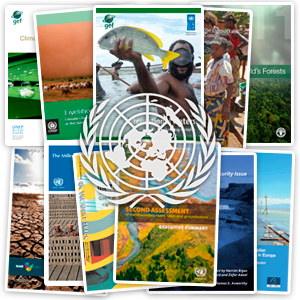- ON THE DECADE
- THE DECADE'S CAMPAIGN
- REPORTING ON PROGRESS
- THE DECADE'S PROGRAMMES
- FOCUS AREAS
-
- Access to sanitation
- Financing water
- Gender and water
- Human right to water
- Integrated Water Resources Management
- Transboundary waters
- Water and cities
- Water and energy
- Water and food security
- Water and sustainable development
- Water and the green economy
- Water cooperation
- Water quality
- Water scarcity
- FOCUS REGIONS
- RESOURCES FOR
- UN e-RESOURCES
Financing water
Increasing people's access to sanitation and drinking-water brings large benefits to the development of individual countries through improvements in health outcomes and the economy.
The impact of diarrhoeal disease on children is greater than the combined impact of human immunodeficiency virus/acquired immunodeficiency syndrome (HIV/AIDS), tuberculosis and malaria; we also know that the provision of improved sanitation and drinking-water could reduce diarrhoeal diseases by nearly 90%. Latest estimates indicate that improvements in sanitation and drinking-water could reduce the number of children who die each year by 2.2 million. Huge savings in health-care costs and gains in productive days can therefore be realized by improving access to safe water and basic sanitation.
Despite these clear benefits for human development, many countries seem to allocate insufficient resources to meet the Millennium Development Goal (MDG) target for sanitation and drinking-water. When compared with other sectors, particularly the other major social sectors of education and health, sanitation and drinking-water receive a relatively low priority for both official development assistance (ODA) and domestic allocations.
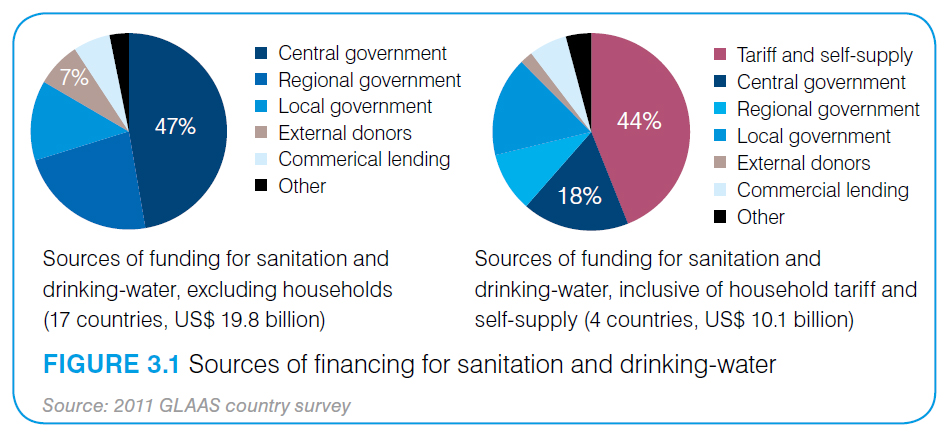
Historical data show that sanitation and drinking-water enjoyed more than 8% of total ODA in 1997. At that time, other social infrastructure sectors, such as health, education, population and reproductive health, received lower proportions of aid compared with sanitation and drinking-water. During the 11 years since 1997, however, the proportion of development aid allocated to sanitation and drinking-water fell from 8% to 5%, while development aid allocated to health increased from 7% to 11.5% and that for education remained steady at around 7%.
Sources:
- GLAAS 2012 Report. UN-Water Global Analysis and Assessment of Sanitation and Drinking Water. WHO, UN-Water. April 2012
- Progress on Drinking Water and Sanitation. 2012 update. UNICEF, WHO, March 2012.
- UN-Water Global Annual Assessment of Sanitation and Drinking Water (GLAAS) 2010. Targeting resources for better results. WHO, 2010
The benefits of investing in water and sanitation
The economic benefits of investing in drinking-water and sanitation come in several forms:
- health-care savings by health agencies and individuals;
- productive days gained per year (for those 15-59 years of age) and increased school attendance;
- time savings (working days gained) resulting from more convenient access to services;
- value of deaths averted (based on future earnings).
Source Evaluation of the Costs and Benefits of Water and Sanitation Improvements at the Global Level. WHO, 2004
Sanitation: the forgotten sister
Sanitation has been severely neglected. Estimates of the cost of achieving the 2015 Millennium Development Goal target for sanitation vary widely, due to differences in approach and a weak information base. The World Health Organization estimates the total annual cost of meeting the target at just over $9.5 billion. If estimates of current costs are correct, resources in the sanitation sector would have to be almost doubled to meet the 2015 target (although estimates of current spending probably underestimate the contributions by households to their own sanitation services). If the full cost of tertiary wastewater treatment for waste streams in urban areas is added, the total rises to $100 billion, the current value of total annual official development assistance (ODA).
In 2008, financing for sanitation comprised 37% of total aid funding for sanitation and drinking-water.
Sources:
- 3rd United Nations World Water Development Report: Water in a Changing World. Chapter 4. WWAP, 2009
- UN-Water Global Annual Assessment of Sanitation and Drinking Water (GLAAS) 2010
Did you know?
- Achieving the water and sanitation MDG target could bring economic benefits, ranging from US$ 3 to US$ 34 per US$ 1 invested, depending on the region
- Additional improvement of drinking-water quality (e.g. point-of-use treatment), if sustained, could lead to a benefit t ranging from US$ 5 to US$ 60 per US$ 1 invested.
To know more
 Tracking national financial flows into sanitation, hygiene and drinking-water
Tracking national financial flows into sanitation, hygiene and drinking-water
World Health Organization (WHO). July 2012
This working paper lays out basic proposals for a common methodology to track WASH financial flows at the national level. It outlines a process that countries will need to go through in order to derive more comprehensive and reliable estimates of spending on WASH at the national level. The objectives of this working paper are twofold:
- to determine the state of the evidence on the monitoring and reporting of financial flows to the water, sanitation and hygiene (WASH) sector at the national level;
- if knowledge gaps are confirmed, to identify the key tenets of a methodological framework that could significantly improve our understanding of financial flows in the WASH sector and be rolled out in a large number of countries as part of UN-Water Global Analysis and Assessment of Sanitation and Drinking-Water (GLAAS) 2014 and beyond.
 Achieving Financial Sustainability and Recovering Costs in Bank Financed Water Supply and Sanitation and Irrigation Projects
Achieving Financial Sustainability and Recovering Costs in Bank Financed Water Supply and Sanitation and Irrigation Projects
International Bank for Reconstruction and Development (IBRD), World Bank Water Partnership Program (WPP). June 2012
This preliminary background Note is divided into four parts: 1) A "history" of the call for financial sustainability and cost recovery, and the parallel documenting of the lack of progress; 2) An outline of options to be considered for achieving financial sustainability of Water Supply and Sanitation (WSS) service providers and recovering WSS service costs through tariffs. 3) A discussion on what makes financial sustainability of irrigation projects different from WSS projects; and 43) A summary of recommendations to teams involved in the identification, preparation, appraisal and supervision of water projects and of practical measures and actions.
 GLAAS 2012 Report. UN-Water Global Analysis and Assessment of Sanitation and Drinking-Water
GLAAS 2012 Report. UN-Water Global Analysis and Assessment of Sanitation and Drinking-Water
World Health Organization (WHO), UN-Water. April 2012
The objective of the UN-Water Global Analysis and Assessment of Sanitation and Drinking-Water (GLAAS) is to monitor the inputs required to extend and sustain water, sanitation and hygiene systems and services. This includes the components of the “enabling environment”: documenting government policy and institutional frameworks; the volume, sources and targeting of investment; the sufficiency of human resources; priorities and gaps with respect to external assistance; and the influence of these factors on performance. A more challenging secondary goal is to analyse the factors associated with progress, or lack thereof, in order to identify drivers and bottlenecks, to identify knowledge gaps, to assess strengths and weaknesses, to identify challenges, priorities and successes, and to facilitate benchmarking across countries. This second UN-Water GLAAS report presents data received from 74 developing countries, covering all the Millennium Development Goal regions, and from 24 external support agencies, representing approximately 90% of official development assistance for sanitation and drinking-water.
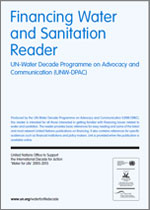 Financing Water and Sanitation Reader
[
Financing Water and Sanitation Reader
[ - 139 KB]
- 139 KB]
UN-Water Decade Programme on Advocacy and Communication (UNW-DPAC). 2010
This reader is intended for all those interested in getting familiar with financing issues related to water and sanitation. The reader provides basic references for easy reading and some of the latest and most relevant United Nations publications on financing. It also contains references for specific audiences such as financial institutions and policy makers. Link is provided when the publication is available online.
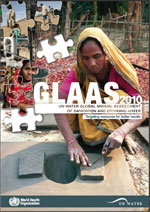 UN-Water Global Annual Assessment of Sanitation and Drinking Water (GLAAS) 2010. Targeting resources for better results
[
UN-Water Global Annual Assessment of Sanitation and Drinking Water (GLAAS) 2010. Targeting resources for better results
[ - 21 MB]
- 21 MB]
World Health Organization (WHO). 2010
The purpose of the GLAAS report is to provide key information, based on data collected from a large number of sources, concerning sanitation and drinking-water in the developing world: specifically, the use of sanitation and drinking-water services, government policies and institutions, investments of financial and human resources, foreign assistance and the influence of these factors on performance. It strives to enable comparisons to be made across countries and regions and is expected to achieve global reporting within the coming years. This first report covers 42 countries and 27 external support agencies.
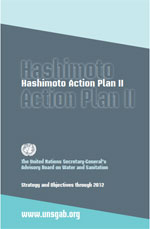 Hashimoto Action Plan II
[
Hashimoto Action Plan II
[ - 129 KB]
- 129 KB]
United Nations Secretary-General's Advisory Board on Sanitation (UNSGAB). 2010
The Hashimoto Action Plan II articulates a time-bound vision, targeted actions and outcomes aiming to ensure the achievement of the Millennium Development Goal water-related target. It provides recommendations to its partners to achieve objectives in five key areas: financing, sanitation, monitoring and reporting, integrated water resources management and water and disaster.
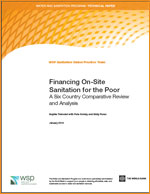 Financing On-Site Sanitation for the Poor. A Six Country Comparative Review and Analysis
[
Financing On-Site Sanitation for the Poor. A Six Country Comparative Review and Analysis
[ - 2.35 MB]
- 2.35 MB]
World Bank Water and Sanitation Program (WSP). 2010
This research seeks to identify the best-performing approaches and the relevant factors and issues to consider in designing a sanitation financing strategy. The report offers guidance to sector professionals developing on-site sanitation projects and programs, which play a leading role in providing access to sanitation. The study compares alternative financing approaches based on a set of common indicators, including in terms of the effectiveness in the use of public funds and targeting. The report also shows that households are key investors in on-site sanitation, and careful project design and implementation can maximize their involvement, satisfaction, and financial investment. The study covers six cases from Bangladesh, Ecuador, India, Mozambique, Senegal and Vietnam.
 3rd United Nations World Water Development Report: Water in a Changing World. Chapter 4
[
3rd United Nations World Water Development Report: Water in a Changing World. Chapter 4
[ - 827 KB]
- 827 KB]
World Water Assessment Programme (WWAP). 2009
The United Nations World Water Development Report, released every three years, provides a mechanism for monitoring changes in the resource and its management and tracking progress towards achieving targets, particularly those of the Millennium Development Goals (MDGs) and the World Summit on Sustainable Development. The Reports also offer best practices as well as in-depth theoretical analyses to help stimulate ideas and actions for better stewardship in the water sector. Chapter 4 of the 3rd edition of the UN World Water Development Report focuses on financing issues.
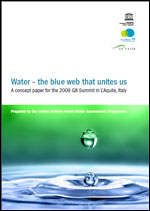 Water - the blue web that unites us
[
Water - the blue web that unites us
[ - 1.8 MB]
- 1.8 MB]
World Water Assessment Programme (WWAP). 2009
This report presents a brief review of progress made since the Water Action Plan agreed at the 2003 G8 Summit in Evian, France. It includes an introduction to some of the key themes of the United Nations World Water Development Report 3: Water in a Changing World, and proposes then some priority areas for discussion at the 2009 G8 Summit in Abruzzo, Italy. Chapter IV 'Putting water onto a sounder financial footing' specifically covers the financing issue.
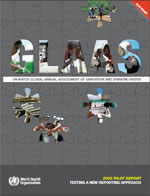 UN-Water Global Annual Assessment of Sanitation and Drinking-Water (GLAAS) 2008 pilot report. Testing a new reporting approach
[
UN-Water Global Annual Assessment of Sanitation and Drinking-Water (GLAAS) 2008 pilot report. Testing a new reporting approach
[ - 7.6 MB]
- 7.6 MB]
World Health Organization (WHO). 2008
This GLAAS pilot report presents the concept of a possible global, periodic, comprehensive reporting mechanism to inform policymaking in the sanitation and drinking-water sectors. Among the specific objectives of this pilot report are to present an all-round view of the sanitation and drinking-water sectors by collecting information on country capacities, national financing and external aid priorities; assess the ability of countries and external support agencies to compile institutional and financial data in the sanitation and drinking-water sectors for use in periodic sector reporting; stimulate discussion on the development of better indicators to monitor progress in the sanitation and drinking-water sectors; show lessons learned and recommend a way forward to the possible establishment of a global periodic comprehensive reporting mechanism on the sanitation and drinking-water sectors.
 The Challenge of Financing Sanitation for Meeting the Millennium Development Goals [
The Challenge of Financing Sanitation for Meeting the Millennium Development Goals [ - 456 KB]
- 456 KB]
World Bank Water and Sanitation Program (WSP). 2004
In addressing the challenge of financing sanitation, this paper explores three strategic issues: (a) ways to find effective strategies and funding mechanisms for sanitation promotion while ensuring rapid service expansion, (b) ways to leverage household, community, local government and other market based resources for the sector while ensuring demand responsive approaches, (c) ways to (re)design public finance strategies for sanitation which focus on identifying: approaches for accelerating sustainable sanitation access, institutional mandates, sources of finance and financing mechanisms, trade-offs in allocation and performance of monitoring systems. These issues are developed using examples and case studies from several countries. The paper concludes with actions required by key stakeholders.
Financing water around the world
Africa
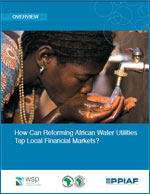 How Can Reforming African Water Utilities Tap Local Financing Markets?
[
How Can Reforming African Water Utilities Tap Local Financing Markets?
[ - 1.3 MB]
- 1.3 MB]
World Bank Water and Sanitation Program (WSP). 2007 (Revised 2009)
A regional workshop held in Pretoria, South Africa in August 2006 assessed the scope for 'Market Finance for Water Utilities in Africa'. The workshop focused on two finance related obstacles to achieving the Millennium Development Goals (MDGs) on water and sanitation: mobilization of additional funding resources to develop the water sector; and ensuring that these investments result in sustainable service delivery. This paper draws on presentations and discussions from the workshop as well as six utility case studies and 14 utility questionnaires.
Financing Small Water Supply and Sanitation Service Providers. Exploring the Microfinance Option in Sub-Saharan Africa [ - 1.15 MB]
- 1.15 MB]
World Bank Water and Sanitation Program (WSP). 2003
This paper discusses the development of the microfinance sector and services in sub-Saharan Africa and the potential demand for financial services by small water and sanitation service providers. The role of governments and development partners in facilitating the finance and credit for small providers is also discussed.
>> Water for Life Voices campaign
>> Submit your voice!
>> Your #WaterForLifeVoices on Flickr
![]() Flickr
Flickr
![]() Slideshare
Slideshare
![]() Twitter
Twitter
![]() YouTube
YouTube

>> Outcome Document from OWG on Sustainable Development Goals
>> A Post-2015 Global Goal for Water: Synthesis of key findings and recommendations from UN-Water 
>> Post 2015 Water Thematic Consultation Report
>> Report of the High-Level Panel of Eminent Persons on the Post-2015 Development Agenda
>> UN-Water section on water in the post-2015 process
>> UN post-2015 agenda
>> DESA section on Post-2015
>> JMP Post-2015 global monitoring
>> Sustainable Development Goals e-Inventory
>> Summary of Stock taking meeting of Intergovernmental Negotiations on the Post-2015 Development Agenda
>> Synthesis Report of the Secretary-General on the Post-2015 Agenda
>> Decade's weekly
The Decade's weekly brings you every week the latest news from the Decade.
>> Bimonthly Publications Review 25, 26 and 27 [ - 546 Kb]
- 546 Kb]
UNW-DPAC. May 2015
>> Previous issues
Sustainable Development
15-17 January 2015: UN-Water International Zaragoza Conference ‘Water and Sustainable Development: From vision to action’
22 March 2015: World Water Day on Water and Sustainable Development
Biodiversity
2011-2020: UN Decade on Biodiversity
Deserts and Desertification
2010-2020: UN Decade for Deserts and the Fight Against Desertification
Energy
2014-2024: Decade on Sustainable Energy for All
22 March 2014: World Water Day on 'Water and Energy'
Sanitation
2011-2015: Sustainable sanitation: The Five-Year-Drive to 2015
19 November 2014: World Toilet Day
Copyright | Terms of use | Privacy notice | Site Index | Fraud alert | Help










